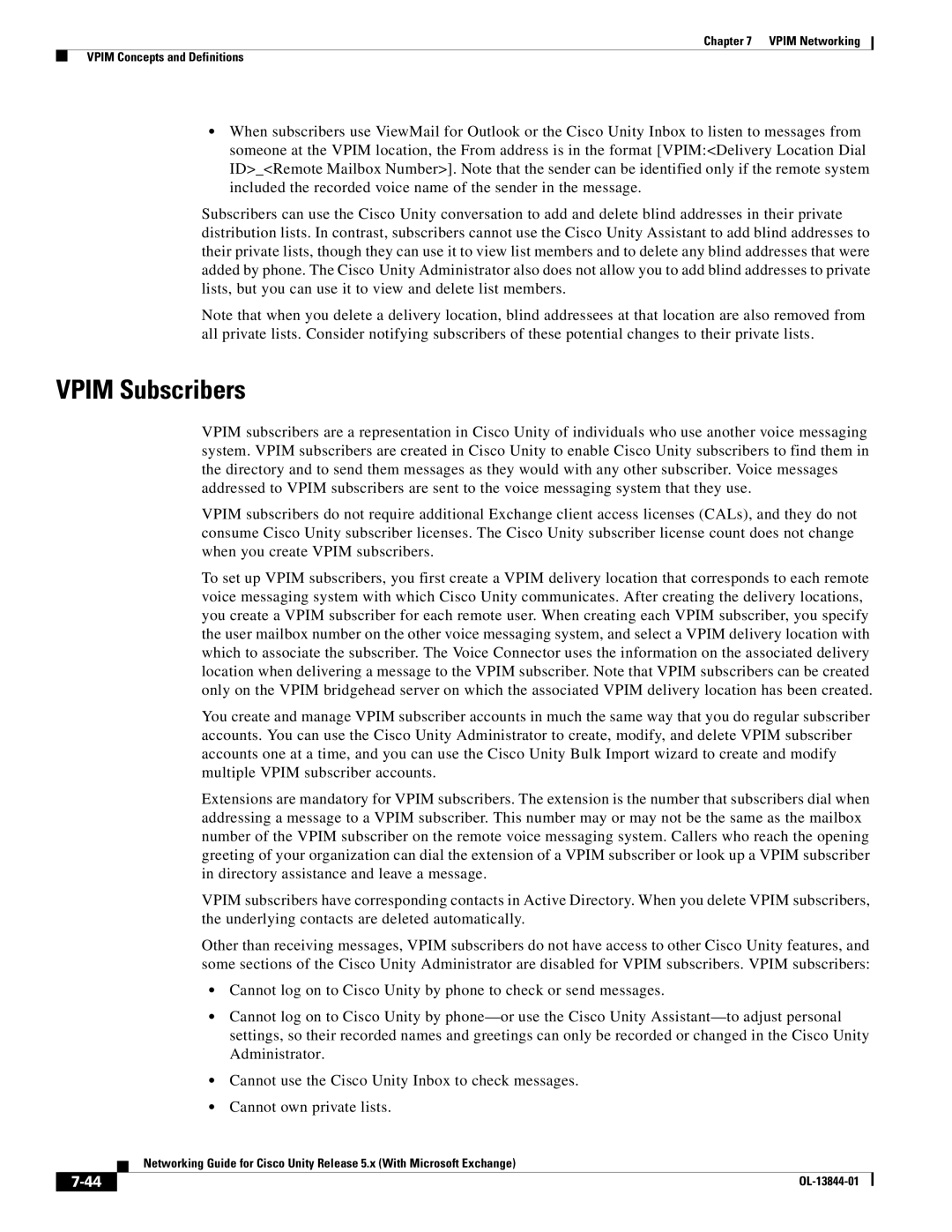
Chapter 7 VPIM Networking
VPIM Concepts and Definitions
•When subscribers use ViewMail for Outlook or the Cisco Unity Inbox to listen to messages from someone at the VPIM location, the From address is in the format [VPIM:<Delivery Location Dial ID>_<Remote Mailbox Number>]. Note that the sender can be identified only if the remote system included the recorded voice name of the sender in the message.
Subscribers can use the Cisco Unity conversation to add and delete blind addresses in their private distribution lists. In contrast, subscribers cannot use the Cisco Unity Assistant to add blind addresses to their private lists, though they can use it to view list members and to delete any blind addresses that were added by phone. The Cisco Unity Administrator also does not allow you to add blind addresses to private lists, but you can use it to view and delete list members.
Note that when you delete a delivery location, blind addressees at that location are also removed from all private lists. Consider notifying subscribers of these potential changes to their private lists.
VPIM Subscribers
VPIM subscribers are a representation in Cisco Unity of individuals who use another voice messaging system. VPIM subscribers are created in Cisco Unity to enable Cisco Unity subscribers to find them in the directory and to send them messages as they would with any other subscriber. Voice messages addressed to VPIM subscribers are sent to the voice messaging system that they use.
VPIM subscribers do not require additional Exchange client access licenses (CALs), and they do not consume Cisco Unity subscriber licenses. The Cisco Unity subscriber license count does not change when you create VPIM subscribers.
To set up VPIM subscribers, you first create a VPIM delivery location that corresponds to each remote voice messaging system with which Cisco Unity communicates. After creating the delivery locations, you create a VPIM subscriber for each remote user. When creating each VPIM subscriber, you specify the user mailbox number on the other voice messaging system, and select a VPIM delivery location with which to associate the subscriber. The Voice Connector uses the information on the associated delivery location when delivering a message to the VPIM subscriber. Note that VPIM subscribers can be created only on the VPIM bridgehead server on which the associated VPIM delivery location has been created.
You create and manage VPIM subscriber accounts in much the same way that you do regular subscriber accounts. You can use the Cisco Unity Administrator to create, modify, and delete VPIM subscriber accounts one at a time, and you can use the Cisco Unity Bulk Import wizard to create and modify multiple VPIM subscriber accounts.
Extensions are mandatory for VPIM subscribers. The extension is the number that subscribers dial when addressing a message to a VPIM subscriber. This number may or may not be the same as the mailbox number of the VPIM subscriber on the remote voice messaging system. Callers who reach the opening greeting of your organization can dial the extension of a VPIM subscriber or look up a VPIM subscriber in directory assistance and leave a message.
VPIM subscribers have corresponding contacts in Active Directory. When you delete VPIM subscribers, the underlying contacts are deleted automatically.
Other than receiving messages, VPIM subscribers do not have access to other Cisco Unity features, and some sections of the Cisco Unity Administrator are disabled for VPIM subscribers. VPIM subscribers:
•Cannot log on to Cisco Unity by phone to check or send messages.
•Cannot log on to Cisco Unity by
•Cannot use the Cisco Unity Inbox to check messages.
•Cannot own private lists.
| Networking Guide for Cisco Unity Release 5.x (With Microsoft Exchange) |
|
